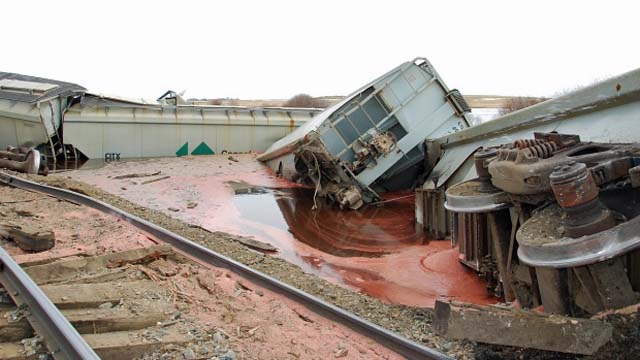
Pose Derailment Risk
Canada - The layoffs of 500 track maintenance workers this week at Canadian Pacific Railway (CP) will raise the risk of future derailments and
potential disasters, the union representing the workers warns.
The Teamsters Canada Rail Conference (TCRC), maintenance division, is also denouncing CP for failing to do a formal risk assessment of how the job cuts could
affect safety along railway lines across Canada, a requirement introduced after the deadly Lake Megantic train disaster in 2013.
"I don't think it's scaremongering at all," division president Gary Doherty told CBC News.
"I think the public should be aware of the potential. My concern is derailments, if we don't have people out there properly maintaining the track or doing
inspections, the potential for disaster is there."
Notices were issued earlier this month, with the Canada-wide layoffs coming into effect Thursday.
In a detailed statement, CP counters it has invested heavily in track infrastructure for years and that this week's layoffs are temporary until business picks
up again.
"For the last 10 years in a row, CP has been the safest Class 1 railroad in North America, measured by train-accident frequency," Martin Cej, the
railway's assistant vice-president of public affairs, said in a statement emailed to CBC.
"The recently announced temporary layoffs are the result of lower car volumes and softening demand in a lacklustre North American economy, factors that
are affecting all railroads, not just CP," he wrote.
Derailments Faulty Tracks
Concern about track maintenance and inspections has mounted recently after the Transportation Safety Board (TSB) investigated three major derailments last year
along Canadian National's (CN) lines through northern Ontario.
The TSB issued a rail safety advisory to Transport Canada (TC), calling on the regulator to pay closer attention and to review CN's "risk
assessments" for the northern railway line.
TSB investigators concluded track failures contributed to the string of crashes, all within the space of a month, near Gogama, Ontario, including one
7 Mar 2015 incident in which 39 rail cars derailed, caught fire, and spilled crude oil into the Makami River.
Investigators found worn rail at that site, which the TSB determined likely contributed to the crash.
The TSB has investigated 13 major derailments in the past decade where investigators concluded track failures, poor maintenance, and failures in oversight by
TC were the primary cause.
Only two of those derailments involved CP.
CP says it has "increased spending on infrastructure" in recent years "installing new track, new ties, new ballast, and doing other work to
ensure a safer railroad.
In addition, more than 700 switches have been removed from active service since 2012, a measure that significantly lessens the risk of incidents across the
network."
Cuts Pose No Risk CP Says
Canada adopted tougher regulations following the Lake Megantic disaster, requiring rail companies to conduct risk assessments of any major changes to
operations or staffing that "may affect the safety of the public, or personnel, or the protection of property, or the environment."
However, CP doesn't believe those regulations apply to these latest job cuts.
"CP carefully considered the changes that were being made and concluded that since they posed no additional risk to employees, the public, property, or
the environment, a risk assessment was not required. TC was notified and agreed with this conclusion," the company said in its statement.
TC initially sidestepped inquiries from CBC, replying that questions on "whether CP has conducted a risk assessment should be addressed to the
company."
But the regulator issued another statement late Friday confirming it was fully aware that no risk assessment has been done.
"Following a review of the information received from CP regarding the temporary layoffs, TC determined that the company is not in violation of the
regulations," wrote spokesperson Roxane Marchand.
"As the situation remains fluid, TC will continue to engage with CP on developments."
Officials have yet to explain why the post-Lake Megantic regulations do not apply to CP in this case or who at TC made the decision.
Critics of Canada's current rail regulatory framework say they worry TC is failing to keep close watch over rail companies.
"It suggests that the world hasn't changed yet," said Mark Winfield, a government regulation expert at York University.
"Despite Lake Megantic, despite the reports from the auditor general, and the TSB, the institutional culture of TC as a regulator, hasn't
changed."
Winfield suggests TC needs to be "much more aggressive" in its oversight of railways.
"And it needs to be much more transparent in how it does that."
Bruce Campbell, a University of Ottawa researcher and former executive director of the Canadian Centre for Policy Alternatives, called the government's
handling of these recent CP layoffs troubling in light of the Lake Megantic findings that identified a lack of "adequate regulatory oversight" as one
of the contributing factors.
"TC had better get its act together," said Campbell, suggesting the regulator doesn't have a "great reputation" right now.
"We've seen main track derailments, and in some cases major accidents with oil trains, since Lake Megantic," he added.
"The third anniversary of the rail disaster is going to be in a couple of weeks. I just hope the public doesn't get lulled into forgetting that lesson of
Lake Megantic, the consequences of regulatory failure."
Dave Seglins.



